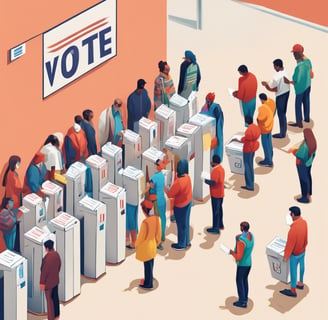Blockchain and DIDs: Revolutionizing Voting for the Digital Age
Outdated voting systems just don’t cut it anymore. The way we vote needs an upgrade.
10/14/20243 min read


In today’s fast-paced world, outdated voting systems just don’t cut it anymore. Voter fraud, low turnout, and contested results have plagued elections globally, eroding public trust. It’s clear: the way we vote needs an upgrade. Enter Blockchain and Decentralized Identifiers (DIDs)—the duo that could revolutionize how we cast our ballots.
The Problem with Traditional Voting
Let’s be real: traditional voting is riddled with problems. From ballot tampering to the long, frustrating wait for results, it’s no wonder people are fed up. And with increasingly digital lives, it’s time for voting to catch up. But how do we ensure security, privacy, and transparency in the digital voting age?
Blockchain: The Transparent Ledger We Need
Imagine a world where every vote cast is immediately recorded on an unchangeable, transparent ledger. That’s exactly what blockchain can do. With blockchain, votes are stored securely across a decentralized network—meaning no single entity has the power to tamper with or alter results. Every vote is public (but anonymous), so anyone can verify the final count in real time. Say goodbye to election night drama!
DIDs: Protecting Voter Identity
While blockchain provides transparency, Decentralized Identifiers (DIDs) offer bulletproof voter authentication. DIDs are unique, digital IDs that prove you are who you say you are—without the need for a central authority like a government or corporation. And the best part? You’re in control of your own data. With DIDs, you can cast your vote securely and privately, ensuring that no one can link your identity to your vote.
This is the digital future we deserve: casting a vote without standing in line, from anywhere, and knowing your voice was counted—fairly.
How It Works Together
Here’s the magic: when you use a DID to vote on a blockchain-based system, you get a voting experience that’s:
Secure: Your identity and vote are verified without exposing personal data.
Transparent: Anyone can see the total votes, but not who voted for whom.
Accessible: With online voting, everyone can participate—no matter where they are.
Use Cases: Blockchain-Based Voting in Action
Indonesia recently launched an ambitious initiative with SettleMint, implementing blockchain technology to verify election results. SettleMint’s solution provided secure, transparent voting processes for elections across 17,000 islands in Indonesia. The technology ensured results were immutable, verifiable, and tamper-proof—transforming the way elections are run in the world's third-largest democracy. This use case showcases blockchain’s ability to scale and handle complex electoral systems, overcoming traditional challenges such as fraud and logistical barriers. Read more about Indonesia’s blockchain voting project.
Estonia: A Pioneer in E-Voting
Estonia is often hailed as the leader in e-voting, and while their system doesn’t yet fully use blockchain, it’s a model for secure, digital voting. Estonia’s system relies on encrypted IDs similar to DIDs. Estonia’s success shows how digital identity frameworks can improve voter access and security. Learn more about Estonia’s digital voting system https://e-estonia.com/wp-content/uploads/factsheet_i-voting.pdfUtah's Blockchain Voting
Utah has also experimented with blockchain voting. In 2020, a Utah voter cast the first on-chain vote in a U.S. presidential election using blockchain technology. Utah’s trials focus on providing secure voting options for overseas military personnel and individuals with disabilities. It has been praised for simplifying the voting process while maintaining security. Learn more https://zenledger.io/blog/the-future-of-voting-how-blockchain-voting-technology-can-enhance-electoral-integrity/Sierra Leone: First Blockchain Presidential Election Audit
In 2018, Sierra Leone made history by becoming the first country to run a blockchain-based election audit. While blockchain didn’t record the actual votes, it was used to verify the integrity of election results after the fact, providing an immutable record. This was a milestone in proving how blockchain can play a crucial role in enhancing trust in election outcomes. Learn more https://www.coindesk.com/markets/2018/03/08/sierra-leone-secretly-holds-first-blockchain-audited-presidential-vote/
These examples show that blockchain is already making strides in voting, and as DIDs become more mainstream, the future of voting could be decentralized, secure, and accessible to all.
Benefits of Blockchain and DIDs for Voting
Tamper-Proof Voting: Blockchain’s immutability means once a vote is cast, it can’t be altered.
Real-Time Transparency: Voters, candidates, and officials can all verify results instantly.
Privacy: DIDs give you total control of your personal information, keeping your identity safe.
Increased Turnout: Voting from your smartphone? Yes, please. This tech can open doors for higher voter participation, especially for those unable to get to the polls.
Challenges and Solutions
Sure, there are challenges. Not everyone is tech-savvy, and rolling out blockchain-based voting requires investment. But these hurdles aren’t insurmountable. With the right infrastructure and education, we can bring voting into the 21st century and build a system that works for everyone.
The Future of Voting
Blockchain and DIDs aren’t just a tech trend—they’re the key to restoring faith in our elections. As countries explore these systems, they’re proving that secure, transparent, and inclusive elections aren’t just a pipe dream—they’re within reach. It’s time we bring voting into the digital age, ensuring every voice is heard and counted fairly.
Copyright Gettone 2022/2024 hello@gettone.io
